|
|
Splitting of Degenerate Superatomic Molecular Orbitals Determined by Point Group Symmetry
Rui Wang, Jiarui Li, Zhonghua Liu, Chenxi Wan, and Zhigang Wang
Chin. Phys. Lett. 2023, 40 (11):
110201
.
DOI: 10.1088/0256-307X/40/11/110201
We first confirm an idea obtained from first-principles calculations, which is in line with symmetry theory: Although superatomic molecular orbitals (SAMOs) can be classified according to their angular momentum similar to atomic orbitals, SAMOs with the same angular momentum split due to the point group symmetry of superatoms. Based on this idea, we develop a method to quantitatively modulate the splitting spacing of molecular orbitals in a superatom by changing its structural symmetry or by altering geometric parameters with the same symmetry through expansion and compression processes. Moreover, the modulation of the position crossover is achieved between the lowest unoccupied molecular orbital and the highest occupied molecular orbital originating from the splitting of different angular momenta, leading to an effective reduction in system energy. This phenomenon is in line with the implication of the Jahn–Teller effect. This work provides insights into understanding and regulating the electronic structures of superatoms.
|
|
|
Dynamically Characterizing the Structures of Dirac Points via Wave Packets
Dan-Dan Liang, Xin Shen, and Zhi Li
Chin. Phys. Lett. 2023, 40 (11):
110302
.
DOI: 10.1088/0256-307X/40/11/110302
Topological non-trivial band structures are the core problem in the field of topological materials. We investigate the topological band structure in a system with controllable Dirac points from the perspective of wave packet dynamics. By adding a third-nearest-neighboring coupling to the graphene model, additional pairs of Dirac points emerge. The emergence and annihilation of Dirac points result in hybrid and parabolic points, and we show that these band structures can be revealed by the dynamical behaviors of wave packets. In particular, for the gapped hybrid point, the motion of the wave packet shows a one-dimensional Zitterbewegung motion. Furthermore, we also show that the winding number associated with the Dirac point and parabolic point can be determined via the center of mass and spin texture of wave packets, respectively. The results of this work could motivate new experimental methods to characterize a system's topological signatures through wave packet dynamics, which may also find applications in systems of other exotic topological materials.
|
|
|
Topological Plasma Transport from a Diffusion View
Zhoufei Liu and Jiping Huang
Chin. Phys. Lett. 2023, 40 (11):
110305
.
DOI: 10.1088/0256-307X/40/11/110305
Recent studies have identified plasma as a topological material. Yet, these researches often depict plasma as a fluid governed by electromagnetic fields, i.e., a classical wave system. Indeed, plasma transport can be characterized by a unique diffusion process distinguished by its collective behaviors. We adopt a simplified diffusion-migration method to elucidate the topological plasma transport. Drawing parallels to the thermal conduction-convection system, we introduce a double-ring model to investigate the plasma density behaviors in the anti-parity-time reversal (APT) unbroken and broken phases. Subsequently, by augmenting the number of rings, we have established a coupled ring chain structure. This structure serves as a medium for realizing the APT symmetric one-dimensional (1D) reciprocal model, representing the simplest tight-binding model with a trivial topology. To develop a model featuring topological properties, we should modify the APT symmetric 1D reciprocal model from the following two aspects: hopping amplitude and onsite potential. From the hopping amplitude, we incorporate the non-reciprocity to facilitate the non-Hermitian skin effect, an intrinsic non-Hermitian topology. Meanwhile, from the onsite potential, the quasiperiodic modulation has been adopted onto the APT symmetric 1D reciprocal model. This APT symmetric 1D Aubry–André–Harper model is of topological nature. Additionally, we suggest the potential applications for these diffusive plasma topological states. This study establishes a diffusion-based approach to realize topological states in plasma, potentially inspiring further advancements in plasma physics.
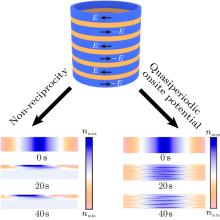
|
|
|
Generation of Ultrafast Attosecond Magnetic Field from Ne Dimer in Circularly Polarized Laser Pulses
Shujuan Yan, Qingyun Xu, Xinyu Hao, Ying Guo, and Jing Guo
Chin. Phys. Lett. 2023, 40 (11):
113101
.
DOI: 10.1088/0256-307X/40/11/113101
By numerically solving time-dependent Schrödinger equations, we investigate the generation of electron currents, ultrafast magnetic fields and photoelectron momentum distributions (PMD) when circularly polarized laser pulses interact with a Ne dimer in the charge migration (CM) process. By adjusting the laser wavelength, we consider two cases: (i) coherent resonance excitation ($\lambda=76$ nm) and (ii) direct ionization ($\lambda=38$ nm). The results show that the current and magnetic field generated by the Ne dimer under resonance excitation are stronger than under direct ionization. This phenomenon is due to the quantum interference between the initial state $2p\sigma_{\rm g}$ and the excited state $3s\sigma_{\rm g}$ under resonance excitation, so the CM efficiency of the dimer can be improved and the strength of the PMD under different ionization conditions is opposite to the strength of the electron current and induced magnetic field. In addition, we also find that both $2p\pi_{\rm g}$ and $2p\pi_{\rm u}$ have coherent resonance excitation with $3s\sigma_{\rm g}$ state and generate periodic oscillating currents for the Ne dimer. The study of the dynamics of the Ne dimer under different ionization conditions lays a foundation for research of ultrafast magnetism in complex molecular systems.
|
|
|
Chirp Compensation for Generating Ultrashort Attosecond Pulses with 800-nm Few-Cycle Pulses
Li Wang, Xiaowei Wang, Fan Xiao, Jiacan Wang, Wenkai Tao, Dongwen Zhang, and Zengxiu Zhao
Chin. Phys. Lett. 2023, 40 (11):
113201
.
DOI: 10.1088/0256-307X/40/11/113201
We show that it is feasible to generate sub-40-attosecond pulses with near-infrared few-cycle pulses centered at 800 nm. With proper gating technique, super-broadband continuum spectrum extending from 50 eV to above 200 eV can be obtained, and the intrinsic atto-chirp can be satisfactorily compensated with C filter, producing isolated attosecond pulses with duration of 33 as. According to the wavelength scaling law of high-order harmonic generation, the proposed scheme is of great significance to develop high-flux ultrashort attosecond sources.
|
|
|
Mechanical Characterization of Broadband Achromatic Optical Vortex Metalens
Zhechun Lu, Yuehua Deng, Yang Yu, Chengzhi Huang, and Junbo Yang
Chin. Phys. Lett. 2023, 40 (11):
114201
.
DOI: 10.1088/0256-307X/40/11/114201
Metalenses, which may effectively manipulate the wavefront of incident light, have been proposed and extensively utilized in the development of various planar optical devices for specialized purposes. However, similar to traditional lenses, the metalens suffers from chromatic aberration problems due to the significant phase dispersion in each unit structure and the limited operational bandwidth. To mitigate the impact of chromatic aberration, we integrate a phase compensation approach with a novel utilization of a phase shift function to define the adjusted phase criterion satisfied by each $\alpha$-Si resonance unit. This approach may lead to development of an innovative optical tweezer known as an achromatic optical vortex metalens (AOVM), offering reliable focusing capabilities across the $1300$ nm and $1600$ nm incident light range. Numerical simulations are conducted to investigate the optical properties of $200$ nm diameter SiO$_{2}$ particles at the focal plane of the AOVM. The trapping ability of the AOVM is successfully validated, exhibiting favorable characteristics including constant optical force, stable kinematic state of trapped particles, and consistent capture positions, surpassing those of the optical vortex metalens.
|
|
|
Intensity-Dependent Dipole Phase in High-Order Harmonic Interferometry
Li Wang, Fan Xiao, Pan Song, Wenkai Tao, Xu Sun, Jiacan Wang, Zhigang Zheng, Jing Zhao, Xiaowei Wang, and Zengxiu Zhao
Chin. Phys. Lett. 2023, 40 (11):
114203
.
DOI: 10.1088/0256-307X/40/11/114203
High-order harmonics are ideal probes to resolve the attosecond dynamics of strong-field recollision processes. An easy-to-implement phase mask is utilized to covert the Gaussian beam to TEM01 transverse electromagnetic mode, allowing the realization of two-source interferometry of high-order harmonics. We experimentally measure the intensity dependence of dipole phase directly with high-order harmonic interferometry, in which the driving laser intensity can be precisely adjusted. The classical electron excursion simulations reproduce the experimental findings quite well, demonstrating that Coulomb potential plays subtle roles on movement of electrons for harmonics near the ionization threshold. This work is of great importance for precision measurements of ultrafast dynamics in strong-field physics.
|
|
|
Preparation of Bi$_{2}$Te$_{3}$ Based on Saturable Absorption System and Its Application in Fiber Lasers
Haoyu Wang, Yue-Jia Xiao, Qi Liu, Xiao-Wei Xing, Hu-Jiang Yang, and Wen-Jun Liu
Chin. Phys. Lett. 2023, 40 (11):
114204
.
DOI: 10.1088/0256-307X/40/11/114204
Fiber laser is a fundamental component of laser systems and is of great significance for development of laser technology. Its pulse output can be divided into $Q$-switched and mode-locked. Achieving ultrashort pulse with narrower pulse duration and higher power is the focus of current research on mode-locked lasers. As an important component of fiber laser systems, saturable absorber (SA) can modulate losses in the optical cavity and generate pulses, enabling the laser system to achieve pulse output under long-term normal operating conditions better. Therefore, expanding the selection range of materials with better saturable absorption properties to improve the quality of pulse output is an important topic in current research. Here, the second generation topological insulator Bi$_{2}$Te$_{3}$ single crystal is prepared, and a ring fiber laser system is built with the Bi$_{2}$Te$_{3}$ SA. The mode-locked pulse with a pulse duration of 288 fs and a signal-to-noise ratio of 80.202 dB is realized. This result verifies that Bi$_{2}$Te$_{3}$, as a member of topological insulator, has good saturable absorption characteristics, and has broad prospects for the application research in lasers.
|
|
|
Near-Field Thermal Splitter Based on Magneto-Optical Nanoparticles
Wen-Xuan Ge, Yang Hu, Lei Gao, and Xiaohu Wu
Chin. Phys. Lett. 2023, 40 (11):
114401
.
DOI: 10.1088/0256-307X/40/11/114401
Based on the many-body radiative heat transfer theory, we investigate a thermal splitter based on three magneto-optical InSb nanoparticles. The system comprises a source with adjustable parameters and two drains with fixed parameters. By leveraging the temperature and magnetic field dependence of the permittivity of InSb, the direction of heat flux in the system can be controlled by adjusting the magnetic field or temperature at the source. Under magnetic field control, the coupling between the separated modes, and the suppression of the zero-field mode induced by the magnetic field, are utilized to achieve a thermal splitting ratio within the modulation range of 0.15–0.58. Furthermore, temperature control results in a thermal splitting ratio ranging from $0.15$ to $0.99$, as a result of the suppression of the zero-field mode by the magnetic field and the blue shift effect of the zero-field mode frequency increasing with temperature. Notably, the gap distance between nanoparticles does not significantly affect the splitting ratio. These findings provide valuable theoretical guidance for utilizing magneto-optical nanoparticles as thermal splitters and lay the groundwork for implementing complex heat flux networks using InSb for energy collection and heat transfer control.
|
|
|
Anomalous Thermal Transport across the Superionic Transition in Ice
Rong Qiu, Qiyu Zeng, Han Wang, Dongdong Kang, Xiaoxiang Yu, and Jiayu Dai
Chin. Phys. Lett. 2023, 40 (11):
116301
.
DOI: 10.1088/0256-307X/40/11/116301
Superionic ices with highly mobile protons within stable oxygen sub-lattices occupy an important proportion of the phase diagram of ice and widely exist in the interior of icy giants and throughout the Universe. Understanding the thermal transport in superionic ice is vital for the thermal evolution of icy planets. However, it is highly challenging due to the extreme thermodynamic conditions and dynamical nature of protons, beyond the capability of the traditional lattice dynamics and empirical potential molecular dynamics approaches. By utilizing the deep potential molecular dynamics approach, we investigate the thermal conductivity of ice-VII and superionic ice-VII$''$ along the isobar of $P = 30$ GPa. A non-monotonic trend of thermal conductivity with elevated temperature is observed. Through heat flux decomposition and trajectory-based spectra analysis, we show that the thermally activated proton diffusion in ice-VII and superionic ice-VII$''$ contribute significantly to heat convection, while the broadening in vibrational energy peaks and significant softening of transverse acoustic branches lead to a reduction in heat conduction. The competition between proton diffusion and phonon scattering results in anomalous thermal transport across the superionic transition in ice. This work unravels the important role of proton diffusion in the thermal transport of high-pressure ice. Our approach provides new insights into modeling the thermal transport and atomistic dynamics in superionic materials.
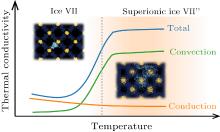
|
|
|
Energy Landscape and Phase Competition of CsV$_{3}$Sb$_{5}$, CsV$_{6}$Sb$_{6}$ and TbMn$_{6}$Sn$_{6}$-Type Kagome Materials
Guanghui Cai, Yutao Jiang, Hui Zhou, Ze Yu, Kun Jiang, Youguo Shi, Sheng Meng, and Miao Liu
Chin. Phys. Lett. 2023, 40 (11):
117101
.
DOI: 10.1088/0256-307X/40/11/117101
Finding viable Kagome lattices is vital for materializing novel phenomena in quantum materials. In this study, we performed element substitutions on CsV$_{3}$Sb$_{5}$ with space group $P6/mmm$, TbMn$_{6}$Sn$_{6}$ with space group $P6/mmm$, and CsV$_{6}$Sb$_{6}$ with space group $R\bar{3}m$, as the parent compounds. Totally 4158 materials were obtained through element substitutions, and these materials were then calculated via density functional theory in high-throughput mode. Afterwards, 48 materials were identified with high thermodynamic stability ($E_{\rm{hull}} < 5$ meV/atom). Furthermore, we compared the thermodynamic stability of three different phases with the same elemental composition and predicted some competing phases that may arise during material synthesis. Finally, by calculating the electronic structures of these materials, we attempted to identify patterns in the electronic structure variations as the elements change. This study provides guidance for discovering promising AM$_{3}$X$_{5}$/AM$_{6}$X$_{6}$ Kagome materials from a vast phase space.
|
|
|
Ferroelectricity and Large Rashba Splitting in Two-Dimensional Tellurium
Yao Wang, Zhenzhen Lei, Jinsen Zhang, Xinyong Tao, Chenqiang Hua, and Yunhao Lu
Chin. Phys. Lett. 2023, 40 (11):
117102
.
DOI: 10.1088/0256-307X/40/11/117102
Two-dimensional (2D) ferroelectric (FE) systems are promising candidates for non-volatile nanodevices. Previous studies mainly focused on 2D compounds. Though counter-intuitive, here we propose several new phases of tellurium with (anti)ferroelectricity. Two-dimensional films can be viewed as a collection of one-dimensional chains, and lone-pair instability is responsible for the (anti)ferroelectricity. The total polarization is determined to be $0.34 \times 10^{-10}$ C/m for the FE ground state. Due to the local polarization field in the FE film, we show a large Rashba splitting ($\alpha_{\scriptscriptstyle{\rm R}} \sim 2$ eV$\cdot$Å) with nonzero spin Hall conductivity for experimental detection. Furthermore, a dipole-like distribution of Berry curvature is verified, which may facilitate a nonlinear Hall effect. Because Rashba-splitting/Berry-curvature distributions are fully coupled with a polarization field, they can be reversed through FE phase transition. Our results not only broaden the elemental FE materials, but also shed light on their intriguing transport phenomena.
|
|
|
Electron-Correlation-Induced Charge Density Wave in FeGe
Lin Wu, Yating Hu, Dongze Fan, Di Wang, and Xiangang Wan
Chin. Phys. Lett. 2023, 40 (11):
117103
.
DOI: 10.1088/0256-307X/40/11/117103
As the first magnetic kagome material to exhibit the charge density wave (CDW) order, FeGe has attracted much attention in recent research. Similar to $A$V$_{3}$Sb$_{5}$ ($A$ = K, Cs, Rb), FeGe exhibits the CDW pattern with an in-plane 2$\times$2 structure and the existence of van Hove singularities near the Fermi level. However, sharply different from $A$V$_{3}$Sb$_{5}$ which has phonon instability at $M$ point, all the theoretically calculated phonon frequencies in FeGe remain positive. Based on first-principles calculations, we surprisingly find that the maximum of nesting function is at $K$ point instead of $M$ point. Two Fermi pockets with Fe-$d_{xz}$ and Fe-$d_{x^{2}-y^{2}}$/$d_{xy}$ orbital characters have large contribution to the Fermi nesting, which evolve significantly with $k_{z}$, indicating the highly three-dimensional (3D) feature of FeGe in contrast to $A$V$_{3}$Sb$_{5}$. Considering the effect of local Coulomb interaction, we reveal that the instability at $K$ point is significantly suppressed due to the sublattice interference mechanism. Meanwhile, the wave functions nested by vector $M$ have many ingredients located at the same Fe site, thus the instability at $M$ point is enhanced. This indicates that the electron correlation, rather than electron-phonon interaction, plays a key role in the CDW transition at $M$ point.
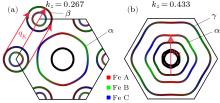
|
|
|
Moiré Synaptic Transistor for Homogeneous-Architecture Reservoir Computing
Pengfei Wang, Moyu Chen, Yongqin Xie, Chen Pan, Kenji Watanabe, Takashi Taniguchi, Bin Cheng, Shi-Jun Liang, and Feng Miao
Chin. Phys. Lett. 2023, 40 (11):
117201
.
DOI: 10.1088/0256-307X/40/11/117201
Reservoir computing has been considered as a promising intelligent computing paradigm for effectively processing complex temporal information. Exploiting tunable and reproducible dynamics in the single electronic device have been desired to implement the “reservoir” and the “readout” layer of reservoir computing system. Two-dimensional moiré materials, with an artificial lattice constant many times larger than the atomic length scale, are one type of most studied artificial quantum materials in community of material science and condensed-matter physics over the past years. These materials are featured with gate-tunable periodic potential and electronic correlation, thus varying the electric field allows the electrons in the moiré potential per unit cell to exhibit distinct and reproducible dynamics, showing great promise in robust reservoir computing. Here, we report that a moiré synaptic transistor can be used to implement the reservoir computing system with a homogeneous reservoir-readout architecture. The synaptic transistor is fabricated based on an h-BN/bilayer graphene/h-BN moiré heterostructure, exhibiting ferroelectricity-like hysteretic gate voltage dependence of resistance. Varying the magnitude of the gate voltage enables the moiré transistor to switch between long-term memory and short-term memory with nonlinear dynamics. By employing the short- and long-term memories as the reservoir nodes and weights of the readout layer, respectively, we construct a full-moiré physical neural network and demonstrate that the classification accuracy of 90.8% can be achieved for the MNIST (Modified National Institute of Standards and Technology) handwritten digits database. Our work would pave the way towards the development of neuromorphic computing based on moiré materials.
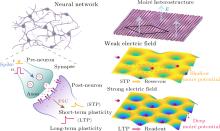
|
|
|
Cooling by Coulomb Heat Drag Based on Three Coupled Quantum Dots
Jin-Zhu Gao, Xing Liu, Jian-Hui Wang, and Ji-Zhou He
Chin. Phys. Lett. 2023, 40 (11):
117301
.
DOI: 10.1088/0256-307X/40/11/117301
We establish a model for a four-terminal thermoelectric system, based on three coupled quantum dots, which consists of a left/right electron reservoir (the source and the drain), two thermal reservoirs and three coupled quantum dots. Based on the master equation theory, we derive the expressions of the electron current and heat flow among the three quantum dots and the corresponding reservoir. We show that the source can be cooled by passing a thermal current between the two thermal reservoirs, with no net heat exchange between the thermal reservoirs and the electron reservoirs. This effect is called the Coulomb heat drag effect. Then, we define the coefficient of performance (COP) and the cooling power. The influence of the main system parameters, such as charging energy, energy level, and temperature, on the performance of the four-terminal thermoelectric system is analyzed in detail. By choosing appropriate parameters one can obtain the maximum cooling power and the corresponding COP. Finally, we also show that the Maxwell demon effect can be realized by using nonequilibrium thermal reservoirs in our four-terminal thermoelectric system.
|
|
|
Emergence of High-Temperature Superconducting Phase in Pressurized La$_{3}$Ni$_{2}$O$_7$ Crystals
Jun Hou, Peng-Tao Yang, Zi-Yi Liu, Jing-Yuan Li, Peng-Fei Shan, Liang Ma, Gang Wang, Ning-Ning Wang, Hai-Zhong Guo, Jian-Ping Sun, Yoshiya Uwatoko, Meng Wang, Guang-Ming Zhang, Bo-Sen Wang, and Jin-Guang Cheng
Chin. Phys. Lett. 2023, 40 (11):
117302
.
DOI: 10.1088/0256-307X/40/11/117302
The recent report of pressure-induced structural transition and signature of superconductivity with $T_{\rm c}\approx80$ K above 14 GPa in La$_{3}$Ni$_{2}$O$_{7}$ crystals has garnered considerable attention. To further elaborate this discovery, we carried out comprehensive resistance measurements on La$_{3}$Ni$_{2}$O$_{7}$ crystals grown in an optical-image floating zone furnace under oxygen pressure (15 bar) using a diamond anvil cell (DAC) and cubic anvil cell (CAC), which employ a solid (KBr) and liquid (glycerol) pressure-transmitting medium, respectively. Sample 1 measured in the DAC exhibits a semiconducting-like behavior with large resistance at low pressures and gradually becomes metallic upon compression. At pressures $P \geqslant13.7$ GPa we observed the appearance of a resistance drop of as much as $\sim$ 50% around 70 K, which evolves into a kink-like anomaly at pressures above 40 GPa and shifts to lower temperatures gradually with increasing magnetic field. These observations are consistent with the recent report mentioned above. On the other hand, sample 2 measured in the CAC retains metallic behavior in the investigated pressure range up to 15 GPa. The hump-like anomaly in resistance around $\sim$ 130 K at ambient pressure disappears at $P\geqslant2$ GPa. In the pressure range of 11–15 GPa we observed the gradual development of a shoulder-like anomaly in resistance at low temperatures, which evolves into a pronounced drop of resistance of 98% below 62 K at 15 GPa, reaching a temperature-independent resistance of 20 $µ \Omega$ below 20 K. Similarly, this resistance anomaly can be progressively shifted to lower temperatures by applying external magnetic fields, resembling a typical superconducting transition. Measurements on sample 3 in the CAC reproduce the resistance drop at pressures above 10 GPa and realize zero resistance below 10 K at 15 GPa even though an unusual semiconducting-like behavior is retained in the normal state. Based on these results, we constructed a dome-shaped superconducting phase diagram and discuss some issues regarding the sample-dependent behaviors on pressure-induced high-temperature superconductivity in the La$_{3}$Ni$_{2}$O$_{7}$ crystals.
|
|
|
Physical Origin of Color Changes in Lutetium Hydride under Pressure
Run Lv, Wenqian Tu, Dingfu Shao, Yuping Sun, and Wenjian Lu
Chin. Phys. Lett. 2023, 40 (11):
117401
.
DOI: 10.1088/0256-307X/40/11/117401
Recently, near-ambient superconductivity was claimed in nitrogen-doped lutetium hydride (LuH$_{3-\delta}$N$_{\rm{\varepsilon}})$. Unfortunately, all follow-up research still cannot find superconductivity signs in successfully synthesized lutetium dihydride (LuH$_{2}$) and N-doped LuH$_{2\pm x}$N$_{y}$. However, a similar intriguing observation was the pressure-induced color changes (from blue to pink and subsequent red). The physical understanding of its origin and the correlation between the color, crystal structure, and chemical composition of Lu–H–N is still lacking. In this work, we systematically investigated the optical properties of LuH$_{2}$ and LuH$_{3}$, and the effects of hydrogen vacancies and nitrogen doping using the first-principles calculations by considering both interband and intraband contributions. Our results demonstrate that the evolution of reflectivity peaks near blue and red light, which is driven by changes in the band gap and Fermi velocity of free electrons, resulting in the blue-to-red color change under pressure. In contrast, LuH$_{3}$ exhibits gray and no color change up to 50 GPa. Furthermore, we investigated the effects of hydrogen vacancies and nitrogen doping on its optical properties. Hydrogen vacancies can significantly decrease the pressure of blue-to-red color change in LuH$_{2}$ but do not have a noticeable effect on the color of LuH$_{3}$. The N-doped LuH$_{2}$ with the substitution of a hydrogen atom at the tetrahedral position maintains the color change when the N-doping concentration is low. As the doping level increases, this trend becomes less obvious, while other N-doped structures do not show a blue-to-red color change. Our results can clarify the origin of the experimental observed blue-to-red color change in lutetium hydride and also provide a further understanding of the potential N-doped lutetium dihydride.
|
|
|
Spin Hall Magnetoresistance in Pt/BiFeO$_{3}$ Bilayer
Anpeng He, Yu Lu, Jun Du, Yufei Li, Zhong Shi, Di Wu, and Qingyu Xu
Chin. Phys. Lett. 2023, 40 (11):
117402
.
DOI: 10.1088/0256-307X/40/11/117402
Multiferroic materials are general antiferromagnets with negligibly small net magnetization, which strongly limits their magnetoelectric applications in spintronics. Spin Hall magnetoresistance (SMR) is sensitive to the orientation of the Néel vector, which can be applied for the detection of antiferromagnetic states. Here, we apply SMR on the unique room-temperature antiferromagnetic multiferroic material BiFeO$_{3}$ (BFO). The angular dependence of SMR in a bilayer of epitaxial BFO (001) and heavy metal Pt is studied. By rotating the sample under a magnetic field of 80 kOe in the film plane, the resistance shows the maximum when the field is perpendicular to the current while it shows the minimum when the field is along the current. This can be well explained by the SMR in the bilayer of heavy metal/antiferromagnet with the relative orientation between the Néel vector and current direction. In contrast, the angular dependence of the resistance of Pt directly deposited on a SrTiO$_{3}$ (001) substrate shows a 90$^{\circ}$ shift with the magnetic field rotating in the film plane, which originates from the Hanle magnetoresistance of Pt. The obtained spin mixing conductance at the Pt/BFO interface clearly confirms the efficient spin transmission. Our results provide a possible solution for applications of antiferromagnetic multiferroic materials in spintronics.
|
|
|
Giant 2D Skyrmion Topological Hall Effect with Ultrawide Temperature Window and Low-Current Manipulation in 2D Room-Temperature Ferromagnetic Crystals
Gaojie Zhang, Qingyuan Luo, Xiaokun Wen, Hao Wu, Li Yang, Wen Jin, Luji Li, Jia Zhang, Wenfeng Zhang, Haibo Shu, and Haixin Chang
Chin. Phys. Lett. 2023, 40 (11):
117501
.
DOI: 10.1088/0256-307X/40/11/117501
The discovery and manipulation of topological Hall effect (THE), an abnormal magnetoelectric response mostly related to the Dzyaloshinskii–Moriya interaction (DMI), are promising for next-generation spintronic devices based on topological spin textures such as magnetic skyrmions. However, most skyrmions and THE are stabilized in a narrow temperature window either below or over room temperature with high critical current manipulation. It is still elusive and challenging to achieve large THE with both wide temperature window till room temperature and low critical current manipulation. Here, using controllable, naturally oxidized sub-20 and sub-10 nm 2D van der Waals room-temperature ferromagnetic Fe$_{3}$GaTe$_{2-x}$ crystals, we report robust 2D skyrmion THE with ultrawide temperature window ranging in three orders of magnitude from 2 to 300 K, in combination with giant THE of $\sim$ 5.4 $µ \Omega\cdot$cm at 10 K and $\sim$ 0.15 $µ \Omega\cdot$cm at 300 K, which is 1–3 orders of magnitude larger than that of all known room-temperature 2D skyrmion systems. Moreover, room-temperature current-controlled THE is also realized with a low critical current density of $\sim$ $6.2\times10^{5}$ A$\cdot$cm$^{-2}$. First-principles calculations unveil natural oxidation-induced highly enhanced 2D interfacial DMI reasonable for robust giant THE. This work paves the way to room-temperature electrically controlled 2D THE-based practical spintronic devices.
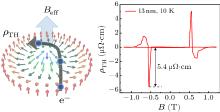
|
|
|
Magneto-Orientated Graphite Double-Layer Homo-Structure with Broadband Microwave Absorption
Jun-Song Wang, Wei Ding, Cheng-Hong Zhang, Kang Qiu, You-Lin Gao, Mian-Ke Chen, Muhammad Adnan Aslam, Mahmoud A. Khalifa, Jia-Liang Luo, Jun Fang, and Zhi-Gao Sheng
Chin. Phys. Lett. 2023, 40 (11):
118101
.
DOI: 10.1088/0256-307X/40/11/118101
We utilized magnetic fields as an efficient tool to manipulate the orientation and electromagnetic properties of graphite micro-flakes (GMFs). As a result, we successfully developed a GMF double-layer homo-structure, which shows excellent electromagnetic absorption properties. By tuning the direction of a small magnetic field (850 G), vertical and horizontal aligned GMFs are produced. Their electromagnetic parameters are effectively tailored by this magneto-orientation effect, and the vertical and horizontal aligned GMFs achieve good results in terms of impedance matching and microwave absorption. With the combination of these two magneto-orientated layers, vertically oriented as the surficial impedance matching layer and horizontally oriented as the inner loss layer, we design a GMF-based double-layer homo-structure. After thickness optimization, $-38.2$ dB minimum reflection loss and 6.4 GHz (11.6–18.0 GHz) absorption bandwidth are achieved. Our findings further emphasize the importance of material orientation freedom and provide a magneto-strategy to design multiple-layer structures and to produce high-performance microwave devices.
|
26 articles
|




